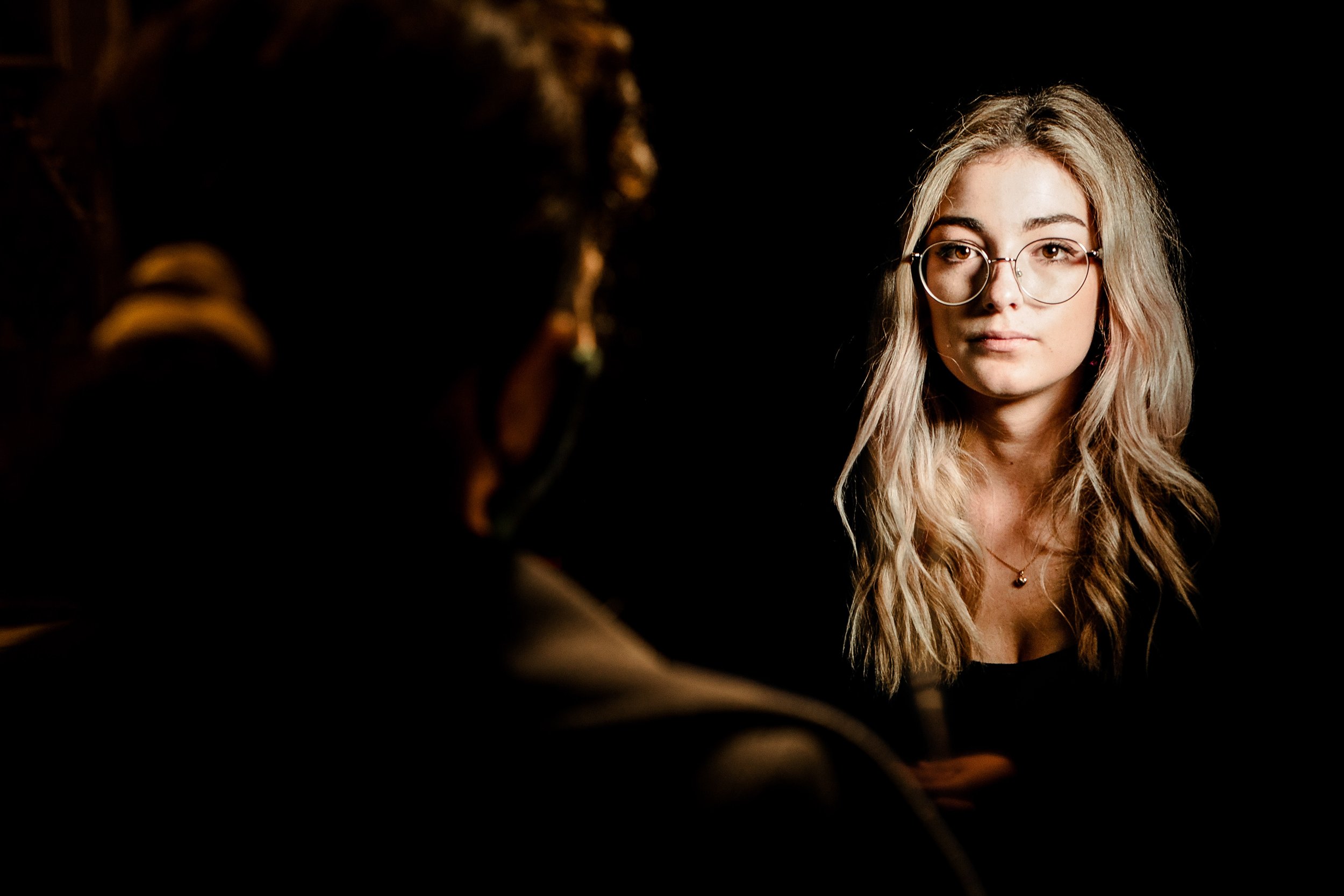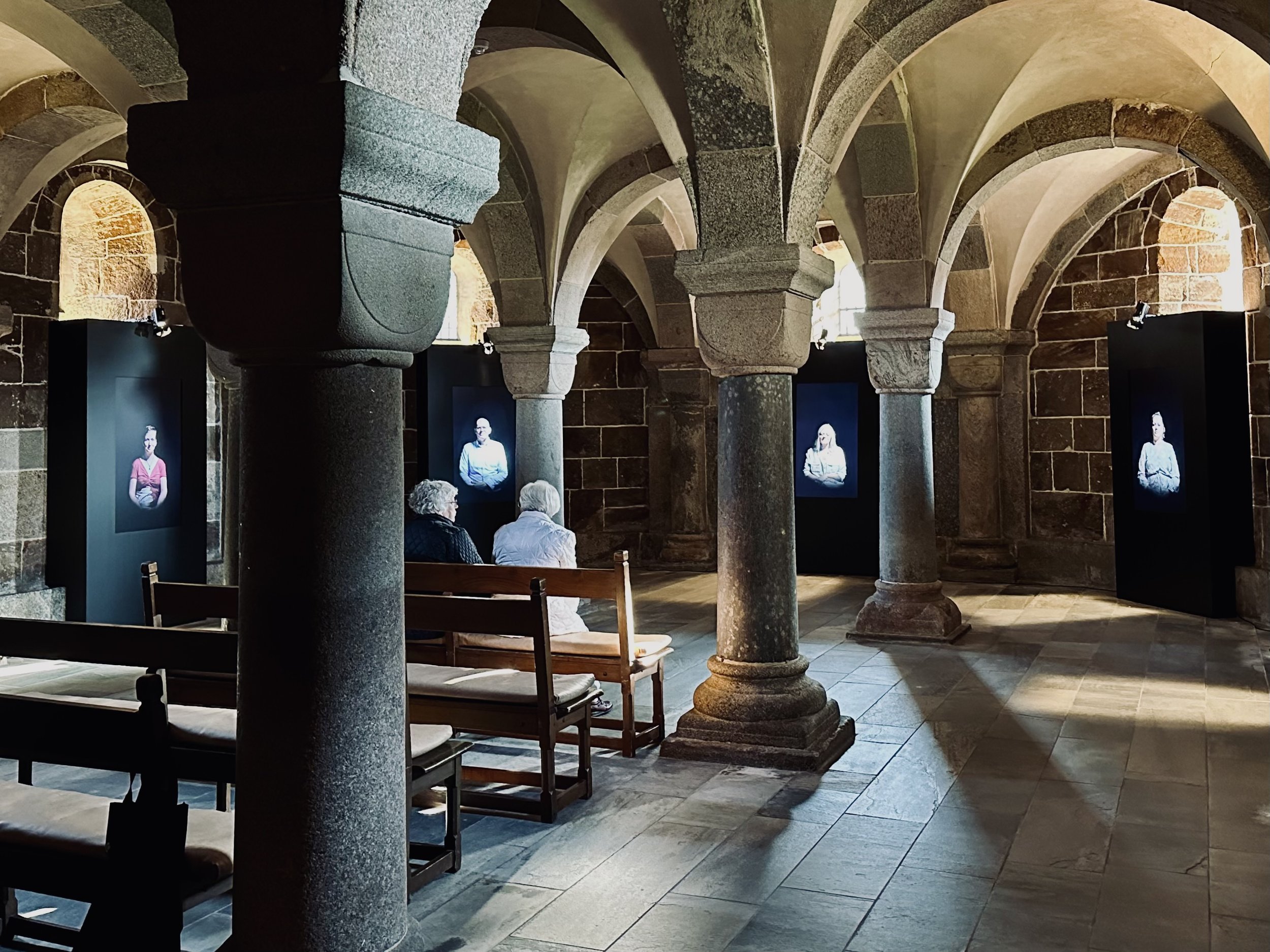People We Love
Multi-Screen Video Installation (2020)
Multiple high-definition screens, exquisitely lit, show a video portrait of a different face. Each person is gazing at a picture of someone they love. A picture you’ll never see….
-

The Work
Viewers of People We Love meet the penetrating gaze of the work’s subjects, never knowing who the focus of their detailed attention is. In the most direct sense, the aesthetic subjects of the work, i.e. the people we love, are absent and can only be conjured into existence through an act of imagination on the viewer’s behalf.
The work turns on this: love and empathy start as an act of imagination.
We can only guess what joy or tragedy that wistful smile points to. People We Love asks us to imagine. And in the act of imagining, the ‘art’ is made. It’s a shared transaction prompted by the subjects and made by the viewer.
Each viewer’s role as co-creator of an invisible core aesthetic is further emphasised by a narrow beamed spotlight which illuminates their presence as they stand before the work.
People We Love seeks to engage with and provoke the broadest of audiences whilst asking complex and prescient questions about where the work's aesthetic can be located, who makes it, and who owns it.
International in scale, each edition is made with the direct participation of local host communities.
-
Artist's Statement
The act of looking intently into the face of another, of staring and probing, of questioning the changing features of a stranger’s countenance, watching every twitch and blink for signs of the story beneath, is a revelation. This opportunity to look, in detail, to examine, both analytically and empathically, is a rarity. On those few other cultural occasions when a stare is invited, it’s usually a request to look upon a carefully curated face; a portrait of success perhaps, or an advertisement, the message and the face inextricably interwoven.
The subjects of People We Love, filmed while looking at a loved one, seem to have been stripped of all self-consciousness. They meet our questioning gaze without artifice or hostility. Instead, they stare back with honesty, vulnerability, and love. I find in all of these faces a silent affirmation of much that is best about being human, about the love that binds us, the stories that connect us, the light we create for ourselves, partly in acknowledgment and partly in defiance, of the pain and suffering that accompanies us all.
Kit Monkman
-

Performance History
November 2023
ArtHouse Jersey, Jersey (7th Edition)September 2023
Viborg Cathedral, Denmark (6th Edition)May 2023
Castle Howard, UK (5th Edition)February 2023
Selby Abbey , Selby, UK (4th Edition)October 2022
Aesthetica Short Film Festival, York, UK (2nd Edition)September 2022
Viborg Kunsthal, Denmark (2nd Edition, abridged)April 2022
Pittsburgh, USA (3rd Edition)October 2021
York Minster, York, UK (2nd Edition)October 2020
York Minster, York, UK (1st Edition)
“It is about that different way of communicating about our lives, which is what stories are ultimately all about. That different way of reaching out to another. That different way of being human together. That different way of understanding what understanding can be."
Professor Jenna Ng
The face, then, as that unique vehicle of storytelling in People We Love. Against a plain black background, each face holds relatively still; each face conveys its essence: Here I Am. Yet these faces also show life, memories, vitality, soul. Eyes blink. Sometimes they tear. The subtle movements of facial muscles fidgeting, restless, then settling again. The corners of the mouth that twitch, or turn slightly upwards, or sometimes just shiver with the ghosts of recollection. These faces say: Here I Am… and Here I Am, Telling You My Story.
Or, rather, half of the story. The rest is completed only when the viewer – live, real, in three-dimensions – steps up to the screen. The two faces now confront each other, suddenly connecting across anachronous worlds forged over a physically correct eyeline and their single common context of understanding: one is looking at someone they love; the other is looking at them looking at someone they love.
In that collision, the story is created. Wordless, unspoken. But told. Prised by the viewer from the stranger’s face; mined between Platonic essence and existential being. This is storytelling at possibly its most abstract: it is difficult to consider how it may be stripped down any further. This is also storytelling at its most democratic. There is no top down grand narrative, no fiercely protected canon, no “official” text. This is a story that is shared with utmost sincerity: the face onscreen accepts their story needs to be received on the viewer’s terms; the viewer acknowledges that they must do the work to get the result.
But that sincerity is what makes People We Love so magical. It is not simply an entirely original form of story and storytelling, although those endeavours are undoubtedly part of the project. It is about that different way of communicating about our lives, which is what stories are ultimately all about. That different way of reaching out to another. That different way of being human together. That different way of understanding what understanding can be.
Professor Jenna Ng
Professor of Digital Media and Culture, University of York.








